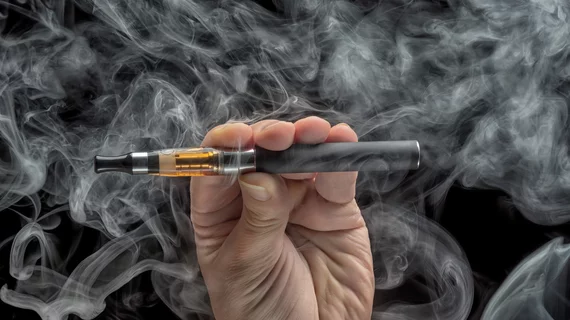Hospital giant Intermountain releases best practices to help diagnose, treat vaping-related lung disease
Clinicians from noted hospital system Intermountain Healthcare recently released best practices to help radiologists and others assess and treat electronic cigarette or vaping-associated lung injury (EVALI).
Providers at the Salt Lake City, Utah-based institution have already treated dozens of patients with the condition across its 24 hospitals. They’re hoping to share early learnings while urging others to stay vigilant for the signs of the disease as cold and influenza cases start multiplying during the winter. Their early learnings were highlighted Friday, Nov. 8, in the journal Lancet.
“Through sharing the guideline, we’re reaching clinicians and keeping e-cigarette or vaping-associated lung injury on everyone’s minds, especially as we enter flu season and diagnosing vaping associated lung injury becomes more challenging,” Denitza Blagev, MD, a pulmonary and critical care physician at Intermountain and lead author of the analysis, said in a statement.
All told, 60 EVALI sufferers presented at 13 different Intermountain hospitals between June and October. Their condition was characterized by a history of using vaping products in the past three months and abnormalities in chest imaging with no other obvious causes.
Intermountain experts advocate for shorter courses of moderate-dose steroids for those treated as outpatients, and higher doses of IV steroids, tapered slowly, for others who present as critically ill at admission. They also recommend close outpatient follow-up to keep an eye on complications.
The majority of EVALI sufferers treated at Intermountain were admitted to the intensive care unit and recovered quickly. Typically, they showed flu-like symptoms, shortness of breath, cough, chest pain and other abdominal symptoms. Most received antibiotics, oxygen and steroids, since their conditioned mirrored pneumonia, and showed improvement within days.
Six of them, however, relapsed and were readmitted to the hospital, with half having resumed vaping following discharge. In what Intermountain said is the first study to report follow-up findings from EVALI patients, clinicians found at the two-week checkup that most had improved significantly. Others had lingering abnormalities on subsequent imaging tests, and about 23% still required supplementary oxygen.
One of their key takeaways from the experience is to always keep EVALI in mind as a possible diagnosis.
“Being vigilant about obtaining a patient’s vaping history when they’re admitted and keeping it in mind throughout their hospital stay is essential,” Blagev added. “For some patients in our study, their vaping history didn’t emerge until they were well into the course of their disease.”
Intermountain also credited telehealth services for helping the hospital system get a handle on the outbreak. It had intensivist physicians and critical care nurses constantly monitoring data, systemwide, and remotely providing clinical decision support to beside caregivers. They’ve also formed a task force to track and report EVALI cases and help spread best practices.
“The use of the TeleHealth Critical Care service allowed us to recognize the outbreak much earlier than if we had only relied on reports of separate cases in individual hospitals,” Blagev said.
As of Nov. 7, more than 2,050 individuals had been stricken by this form of lung injury in 49 states, the Centers for Disease Control and Prevention reported. Another 39 have died from the disease, with investigators now calling the vitamin E acetate additive in THC-based vaping products a “strong culprit.”

